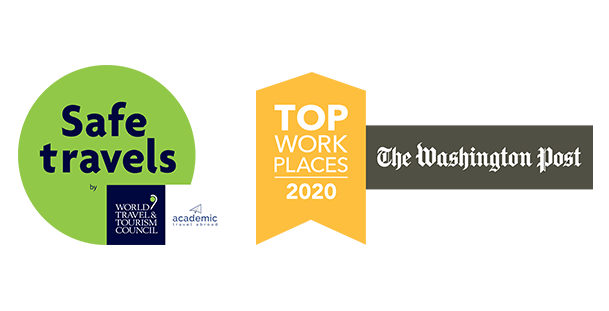A few weeks ago, one of our partners asked us what our “Recession Playbook” looked like. It was the middle of summer: unemployment was at a 50-year low, the Fed just cut interest rates, the Euro was trading favorably, and consumer sentiment was positive. However, news of the U.S’s trade war tactics and political uncertainly heading into an presidential election year gave her pause as she noticed an August slowdown in bookings. ATA is no stranger to recessions; in our nearly 70-year history, we have weathered many economic downturns and external events. Here are a few of our thoughts on how to prepare. What indicators does ATA rely on to try to predict a recession and take action? The most common indicators we look at include: Unemployment: Low unemployment signals fewer available workers for each job opening. This creates demand for skilled workers at higher wages. However, unemployment that drops too low poses inflation risks. Consumer Confidence Index: This index measures U.S. consumers’ degree of optimism in the economy as expressed in consumer spending. Housing Starts: While the rate of home building may not seem related to travel, the construction industry represents nearly 20% of GDP and is seen as a leading indicator of the economy. Why? Home builders will not break ground on new homes if they don’t think the next 12 months will be stable enough to first build, then sell, a new home. US Citizen Air Traffic Overseas: A core responsibility of the Office of Travel & Tourism, located within the Department of Commerce, is to collect, analyze, and disseminate international travel and tourism statistics for the United States. Growth in outbound travel often signals business and consumer confidence. What usually happens to consumer travel behavior in a recession? For affinity travel brands, booking patterns change, particularly if the stock market is volatile. Travelers often book trips closer to departure when they sense economic uncertainty. They may postpone some travel if multiple trips are planned, but not delay or cancel all travel. In addition, we often see bookings slowdown in a presidential election year. What steps can travel planners take now? Strengthen Your Brand Communicate your brand’s unique benefits frequently so your customers really know what you stand for. Create urgency to book travel soon with compelling “calls to action.” “Cast” Your Trips Carefully Trip leadership is often a brand’s most compelling value proposition. Choose and “cast” your faculty, study leader, or expert carefully. Make sure they value their role of “host” as much as “expert.” Focus on Quality Now more than ever, word of mouth referrals are very important. Ensure each element of your customers’ trip experiences is executed flawlessly, from your courteous first phone call to the inquisitive trip survey you send when they return. Keep Marketing Brands that market aggressively though economic downturns come out ahead in retaining customers. Avoid Becoming a Commodity at All Costs It is challenging to compete on price in a recession. Instead, focus on making your trips “unshoppable” in the marketplace by reflecting your organization’s unique culture and values. Diversify Make sure you offer a wide variety of destinations and trip types to appeal to many types of travelers. How has ATA prepared for, and weathered so many recessions? We conserve in the present, but invest for the future. To maintain or improve its performance, a business must sell more or spend less; it’s that simple. When we don’t see sales growth on the horizon, we get very disciplined and creative in how we cut non-essential spending. However, we never sacrifice our investment in the future, and prioritize new program research and development. What We Learned From Past Recessions The Gulf War Era Recession (1990-91) We learned that timing of bookings matter! Travelers who were already booked on trips when the economy softened tended to stay booked, so cancellations were not rampant. Instead, a lack of new bookings weakened tour enrollments during this period. Post 9/11 Economic Shock and 2nd Gulf War Recession (2003) The real effect of September 11th hit the travel industry in 2003 instead of 2002, since many travelers had trips booked in 2002. We learned that relaxing cancellation terms for a period of time to encourage travelers to book travel in an uncertain time was a useful strategy. However, several overleveraged travel companies could not survive the 9/11 shock and the marketplace consolidated into fewer companies. Housing Crisis and the Great Recession (2008-2009) The downturn in travel occurred quickly and precipitously. Starting in the fall of 2008, bookings fell approximately 40% in one season. We learned that we needed to act quickly to cut overhead and reduce expenses. Despite a few lean years, it was a time of unusual creativity and experimentation for ATA that set us up for growth when the economy improved. President Obama’s surprise announcement allowing people-to-people travel to Cuba in 2011 was a serendipitous “game changer” that brought full economic recovery to the educational travel community. We’d love to hear how you’re preparing! Please drop me a note at [email protected].
Expert Advice
How to Launch a Successful Travel Program
Try not to panic, but imagine launching a new travel program from scratch. There are so many details to consider! What is your target market? Where will you travel? How much should a trip cost? How much revenue will the program generate? What do your travelers want? Are you overwhelmed yet? Creating a new travel program can be a daunting task, but if it is done properly, it will pay off for years to come. Here at Academic Travel Abroad, we’ve been navigating the travel industry and providing guidance to our partners for over 65 years. We are experts in the field and have a few tips to share that will help even the most seasoned travel planner launch a new travel program. Get the Whole Team on BoardMany organizations often designate a small team to champion the development of a fledgling travel program. While it is important to have individuals focused on the success of your new travel endeavor, it is equally important to have support all the way up the ladder. Be sure to set clear and definable goals and seek buy-in at all levels of the organization. Give Yourself Enough TimeRome wasn’t built in a day and neither is a successful travel program! It takes an average of 18-24* months for most organizations to get a new travel program off the ground. While this may seem like a long lead time, there are several important decisions to make before marketing trips. After establishing brand standards and designing core programs, trips should enter the marketplace 12-14 months before departure to maximize enrollment. Cutting corners may hinder the success of your program’s initial year, leaving stakeholders questioning its value. This can be avoided by working with a tour operator to clearly outline a timeline from conception to launch. Research, Research, ResearchYou can’t have a successful travel program without travelers. Researching your target market is arguably the most important factor to your success. We cannot stress enough the value of gathering data to support your initiatives. You may already have several innovative ideas for trips that align with your company’s mission and goals, but will your patrons be interested? Analyze your customer list, send out a preliminary survey, and gauge interest in the early stages of program development. Ask questions to identify key market demographics and get a sense of the price point, destination, and trip duration your travelers are most interested in. Work with a Trusted PartnerLast, but certainly not least, find a trusted tour operator to help you navigate your way. Tour operators have an in-depth knowledge of the industry and experience launching new travel programs. They can offer advice and guidance, collaborating with you throughout the process. When you work with a tour operator you gain an invaluable resource and partner. If you are still searching for a tour operator, you’re in the right place because we happen to be one! To learn more about our process and how we can help visit: https://acadtrvlp.wpengine.com/about/what-we-do/. *Please note: A shorter time of only 12 months is generally required when launching only a single trip.
5 Reasons to Embrace Theme-Based Travel
Shared by Academic Travel Abroad’s Marketing and Production Coordinator, Megan Brothers. Today’s traveler is drastically different than yesterday’s tourist. It’s no longer enough to visit Paris to see the Eiffel Tower or the Louvre. Travelers want more. They are searching for a deeper, more authentic connection with even the most well-known destinations. The number of travelers who want to dine with local residents, take behind-the-scenes tours, and learn through hands-on experiences have rapidly increased over the last five years. Travel is transitioning from surface-level vacations to interactive and immersive theme-based travel. What exactly is theme-based travel, anyway? Theme-based travel is defined as a trip that concentrates on a particular subject or topic. Rather than focusing on broad aspects of a destination, theme-based travel delves into topics on a deeper level. Instead of providing a basic tour of Holland, a theme-based approach would focus specifically on the Dutch landscape while barging in Holland during peak tulip season. The possibilities for creating trips based on themes are truly endless. Read on to learn why theme-based travel is worth implementing. 1. Give new legs to old destinations. Renowned tourist hotspots are losing their allure as travel becomes more attainable. Theme-based programs are the perfect remedy for cliché destinations that have fallen prey to travelers’ been there, done that attitude. Take London, for example. Travelers are no longer satisfied with gazing at Parliament from across the river or taking cliché phone-booth photos. They would rather step inside the House of Parliament to discuss the political implications of the Brexit vote with Parliament members, professors, and international experts. Theme-based programs breathe new life into common destinations and make them shine again. 2. Tap into new audiences. Imagine how lucrative a trip could be if it was designed and targeted at a specific audience. When someone has a strong interest, he or she wants to share it with others and expand their knowledge and involvement with it. A generic program to France may appeal to a large audience. However, a more focused French film trip to Cannes can generate even more excitement, especially amongst a niche audience of movie-buffs. Theme-based travel provides countless opportunities to target new niche audiences. 3. Drive loyalty through common bonds. Perhaps the most exciting thing for travelers on theme-based programs is the chance to forge a common bond among peers. Group travel can be intimidating, especially when traveling solo, but theme-based programs provide participants peace-of-mind that others will share their same interests. A themed-trip focusing on D-Day is likely to attract military-history enthusiasts, war veterans, and history professors. Their common interest ensures camaraderie and meaningful engagement. Positive traveler experience drives brand loyalty and encourages repeat travel. After all, who better to promote a new WWII trip to than those who previously enjoyed a D-Day trip? 4. Remove the cliché from travel. Today’s travelers are looking for more unique, authentic, and immersive experiences. Theme-based travel provides new opportunities to visit bucket-list destinations in more meaningful and memorable ways. Visiting Paris to take selfies in front of the Eiffel Tower and eat baguettes in a park isn’t that special. Wouldn’t a tailored French cuisine trip complete with a cooking class taught by a French chef and a meeting with local artisans to learn about regional cheeses be more exciting? Help travelers step out of tourist traps and into unforgettable, immersive experiences by offering unique, theme-based programs. 5. Harness the power of storytelling. It goes without saying that the phrase fear of missing out resonates across all generations. Travelers want to be in the action and share their stories with friends and family. They also want their travels to be unique and impactful. Take Cuba, for example. Which trip description might sound more enticing to a prospective traveler? Generic Option A: Cruise to Cuba and explore the dynamic island. Enjoy a day excursion and relax on Cuba’s beautiful beaches, sightsee from the comfort of an air-conditioned tour bus, and spend the afternoon on a self-guided tour of Museo Nacional de Bellas Artes. Theme-Based Option B: Experience authentic Cuba and meet with a diverse group of locals. On this trip, discuss historic preservation with experts, learn salsa from local dancers, visit schools, art studios, and privately-owned businesses to witness Cuba’s shifting cultural and economic landscape. Eat delicious Cuban-cuisine at local paladars and come home with a hand-rolled cigar, made especially for you by a Cuban factory worker. While both options have their own appealing qualities, Option A might leave travelers lost in a sea of tourists, exploring destinations from the window of a bus. Option B on the other hand, will surely provide immersive experiences and countless storytelling opportunities. Trips with storytelling power drive brand awareness and will encourage others to seek similar travel experiences. Theme-based travel narrows the focus of a trip while simultaneously widening the appeal. There’s no reason to wait—now is the time to capture new audiences and revive old destinations! Welcome to the world of them-based travel.




